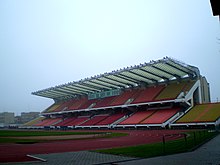Brest, Belarus
Brest (Belarusian: Брэст, romanized: Brest, pronounced [brɛs̪t̪]; Russian: Брест, romanized: Brest, pronounced [brʲes̪t̪]; Polish: Brześć; Lithuanian: Brasta; Ukrainian: Берестя, romanized: Berestia; Yiddish: בריסק, romanized: Brisk), formerly Brest-Litovsk (Belarusian: Берасце, Берасце Літоўскі (Брэст-Лiтоўск); Lithuanian: Lietuvos Brasta; Polish: Brześć Litewski), Brest-on-the-Bug (Polish: Brześć nad Bugiem), is a city (population 350,616 in 2019) in Belarus at the border with Poland opposite the Polish city of Terespol, where the Bug and Mukhavets rivers meet. It is the capital city of the Brest Region.
Brest
| |
|---|---|
City | |
.jpg) | |
 Flag  Coat of arms | |
 Brest Location of Brest in Belarus | |
| Coordinates: 52°08′05″N 23°39′25″E | |
| Country | |
| Region | Brest Region |
| First mention (Primary Chronicle) | 1019 |
| First mention (Novgorod First Chronicle) | 1017 |
| Government | |
| • Chairman of the Brest City Executive Committee | Aleksandr Rogachuk |
| • Chairman of the Brest City Council of Deputies | Nikolai Krasovsky |
| Area | |
| • Total | 145 km2 (56 sq mi) |
| Elevation | 280.4 m (919.9 ft) |
| Population (2019) | |
| • Total | 350,616 |
| • Density | 2,400/km2 (6,300/sq mi) |
| [1] | |
| Time zone | UTC+3 (FET) |
| Postal code | 224000 |
| Area code(s) | +375 (0)162 |
| License plate | 1 |
| Website | Executive committee |
The city of Brest is a historic site of many cultures. It was the location of important historical events such as the Union of Brest and Treaty of Brest-Litovsk. The Brest Fortress was recognized by the Soviet Union as the Hero Fortress in honor of the defense of Brest Fortress in June 1941.
During medieval times, the city was part of the Kingdom of Poland from 1020 until 1319 when it was taken by the Grand Duchy of Lithuania. It became part of the Polish–Lithuanian Commonwealth in 1569. As a result of the Partitions of Poland, it was incorporated into the Russian Empire in 1795. After World War I, the city was conquered by the Second Polish Republic. During the Invasion of Poland by Nazi Germany and the Soviet Union in 1939, the city was first captured by the Wehrmacht and soon passed on to the USSR in accordance with the German–Soviet Frontier Treaty. In 1941, it was retaken by the Germans during Operation Barbarossa. The city was part of the Belarusian SSR until the breakup of the USSR in 1991. Brest is now a part of the independent Belarus.
Etymology
Several theories attempt to explain the origin of the city's name. It may have come from the Slavic root beresta meaning "birch", or "bark". The name could also originate from the Slavic root berest meaning "elm". Or it could have come from the Lithuanian word brasta meaning "ford".[2]
Once a center of Jewish scholarship, the city has the Yiddish name בריסק (Brisk), hence the term "Brisker" used to describe followers of the influential Soloveitchik family of rabbis. Traditionally, Belarusian-speakers called the city Берасце (Bieraście).
Brest became part of the Grand Duchy of Lithuania in 1319.[3] In the Polish–Lithuanian Commonwealth formed in 1569 the town became known in Polish as Brześć, historically Brześć Litewski (literally: "Lithuanian Brest", in contradistinction to Brześć Kujawski). Brześć became part of the Russian Empire under the name Brest-Litovsk or Brest-Litovskii (Russian: Брест-Литовск, Брест-Литовский, literally "Lithuanian Brest") in the course of the Third Partition of the Polish-Lithuanian Commonwealth in 1795. After World War I, and the rebirth of Poland in 1918, the government of the Second Polish Republic renamed the city as Brześć nad Bugiem ("Brest on the Bug") on March 20, 1923.[4] After World War II the city became part of the Byelorussian Soviet Socialist Republic with the name simplified as Brest.
Brest's coat of arms, adopted on January 26, 1991, features an arrow pointed upwards and a bow (both silver) on a sky-blue shield. An alternative coat of arms has a red shield. Sigismund II Augustus, King of Poland and Grand Duke of Lithuania, first granted Brest a coat of arms in 1554.
History
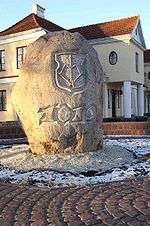
The city was founded by the Slavs. As a town, Brest – Berestye in Kievan Rus – was first mentioned in the Primary Chronicle in 1019 when the Kievan Rus took the stronghold from the Poles. It is one of the oldest cities in Belarus.[5] It was hotly contested between the Polish rulers (kings, principal dukes and dukes of Masovia) and Kievan Rus princes, laid waste by the Mongols in 1241 (see: First Mongol invasion of Poland), and was not rebuilt until 1275. Later it was part of the territory of the Grand Duchy of Lithuania.
In 1390 Brest became the first city in the lands that now comprise Belarus to receive Magdeburg rights. Its suburbs were burned by the Teutonic Knights in 1379.
In 1409 it was a meeting place of King Władysław II Jagiełło, duke Vytautas and Tatar khan under the archbishop Mikołaj Trąba initiative, to prepare for war with the Teutonic Knights. In 1410 the town mustered a cavalry company (banner) that participated in the Polish-Lithuanian victory at the battle of Grunwald. In 1419 it became a seat of the starost in the newly created Trakai Voivodeship. In 1500 it was burned again by Crimean Tatars. In 1566, following king Sigismund II Augustus decree, a new voivodeship was created - Brest Litovsk Voivodeship. After it became part of the Polish–Lithuanian Commonwealth in 1569, it was renamed Brest-Litovsk.
_(2).jpg)
During the period of the union of the Polish–Lithuanian Commonwealth and Sweden under king Sigismund III Vasa (Polish–Swedish union), diets were held there. In 1594 and 1596 it was the meeting-place of two remarkable councils of regional bishops of the Roman-Catholic Church and Eastern Orthodox Church. The 1596 council established the Uniate Church (known also as the Belarusian Greek Catholic Church in Belarus and Ukrainian Greek Catholic Church in Ukraine).
In 1657, and again in 1706, the town and castle were captured by the Swedes during their invasions of the Polish-Lithuanian Commonwealth. In an attack from the other direction, on January 13, 1660 the invading Muscovite Russian army under Ivan Andreyevich Khovansky took the Brest Castle in a surprise early morning attack, the town having been captured earlier, and massacred the 1,700 defenders and their families (according to captain Rosestein, Austrian observer). On July 23, 1792 a battle was fought between the regiments of the Duchy of Lithuania defending the town and the invading Russian Imperial Army.
On September 19, 1794 the area between Brest and Terespol was the scene of a victorious battle won by the invading Russian Imperial army under Suvorov over the Kościuszko Uprising army division under general Karol Sierakowski (known in Russian sources as the Battle of Brest). Brest was annexed by Russia when the Poland-Lithuania Commonwealth was partitioned for the third time in 1795 (see: Partitions of Poland). During Russian rule in the 19th century, a large fortress was built in and around the city. The Russians demolished the Polish Royal Castle and most of the Old Town "to make room" for the fortress.
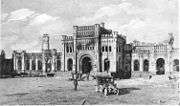
During World War I, the town was captured by the Imperial German Army on August 25, 1915, during the Great Retreat of 1915. Shortly after Brest fell into German hands, war poet August Stramm, who has been called "the first of the Expressionists" and one of, "the most innovative poets of the First World War,"[6] was shot in the head during an attack on nearby Russian positions on September 1 1915.[7]
In March 1918, in the Brest-Litovsk fortress on the western outskirts of Brest at the confluence of the Bug River and Mukhavets Rivers, the Treaty of Brest-Litovsk was signed, ending the war between Soviet Russia and the Central Powers and transferring the city and its surrounding region to the sphere of influence of the German Empire. This treaty was subsequently annulled by the treaties which ended the war and even more so by events and developments in Germany and Eastern Europe. During 1918, the city became a part of the Podolia Governorate of the Ukrainian People's Republic as a result of negotiations and own treaty between delegation of the Ukrainian Central Rada and Central Powers.[8]
The Second Polish Republic
Following the Polish–Soviet War Brest became part of the Second Polish Republic, with borders formally recognized by the Treaty of Riga of 1921. It was renamed Brześć nad Bugiem on March 20, 1923 (Brest on the Bug) in Poland, and named the capital of the Polesie Voivodeship in accordance of the pre-1795 tradition. In the twenty years of Poland's sovereignty, of the total of 36 brand new schools established in the city, there were ten public, and five private Jewish schools inaugurated, with Yiddish and Hebrew as the language of instruction. The first ever Jewish school in Brześć history opened in 1920, almost immediately after Poland's return to independence. In 1936 Jews constituted 41.3% of the Brześć population, or 21,518 citizens. Some 80.3% of private enterprises were run by Jews.[9][10][11] The Polish Army troops of the 9th Military District along with its headquarters were stationed in the fortress.
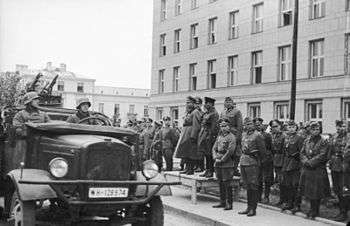
During the German Invasion of Poland in 1939 the city was defended by a small garrison of four infantry battalions under General Konstanty Plisowski against the XIX Panzer Corps of General Heinz Guderian. After four days of heavy fighting the Polish forces withdrew southwards on September 17 (see: Battle of Brześć Litewski). The Soviet invasion of Poland began on the same day and as a result the Soviet Red Army entered the city at the end of September 1939 in accordance with the Ribbentrop-Molotov pact's Secret Protocol, and a joint Nazi-Soviet military parade took place on September 22, 1939. While Belarusians consider it a reunification of the Belarusian nation under one constituency (BSSR at that time), Poles consider it the date when the city was lost. During the Soviet control (1939–41) the Polish population was subject to arrests, executions and mass deportations to Siberia and the Soviet Republic of Kazakhstan.
The city had an overwhelmingly Jewish population in the Russian Partition: 30,000 out of 45,000 total population according to Russian 1897 census, which fell to 21,000 out of 50,000 according to the Polish census of 1931.[12][13]
Operation Barbarossa and beyond
On June 22, 1941, the fortress and the city were attacked by Nazi Germany on the first day of Operation Barbarossa, Germany's invasion of the Soviet Union. The Brest Fortress held out for six days. Abandoned by the Soviet army, nearly all its defenders perished. The Germans placed Brest under the administration of the Reichskommissariat Ukraine. The remaining municipal Jewish population (about 20,000) was sequestered in the Brest ghetto established by the German authorities in December 1941, which they liquidated in October 1942. Only seven Jews survived the Nazi executions.[13] The city was liberated by the Red Army on July 28, 1944.
In early 2019, a mass grave containing the remains of 1,214 people was found in the Brest Ghetto area during a construction project. Most are believed to have been Jews who were killed by the Nazis.[14][15]
Geography
Brest lies astride the Mukhavets River, that is known to Bresters as "the river". The river flows west through the city, dividing it into north and south, and meets the Bug River in the Brest Fortress. The river flows slowly and gently. You can hop into a tire innertube and take a relaxing float down this river. Today the river looks quite broad in Brest. The terrain is fairly flat around Brest. The river has an extremely broad floodplain, that is about 2 to 3 kilometres (1 to 2 miles) across. Brest was subject to flooding in the past. One of the worst floods in recorded history occurred in 1974.
A part of the floodplain was reclaimed by method of hydraulic mining. In the 1980s big cutter-suction dredgers were mining sand and clay from the riverbed, to build up the banks. After the dredging the river became deeper and the riverbanks higher. Today the river does not overflow its banks.
In the 2000s, two new residential areas were developed in the southwest of Brest.
To the east of Brest the Dnieper-Bug Canal was built in the mid-nineteenth century to join the river to the Pina, a tributary of the Pripyat River which in turn drains into the Dnieper River. Thus Brest has a shipping route all the way to the Black Sea. If not for a dam and neglected weirs west of Brest, north-western European shipping would be connected with the Black Sea also.
Climate
Brest has a humid continental climate, but slightly leans towards oceanic due to the irregular winter temperatures that mostly hover around the freezing point. Summers are warm and influenced by its inland position compared to areas nearer the Baltic sea.
| Climate data for Brest | |||||||||||||
|---|---|---|---|---|---|---|---|---|---|---|---|---|---|
| Month | Jan | Feb | Mar | Apr | May | Jun | Jul | Aug | Sep | Oct | Nov | Dec | Year |
| Record high °C (°F) | 11.6 (52.9) |
17.2 (63.0) |
22.6 (72.7) |
30.7 (87.3) |
32.1 (89.8) |
34.0 (93.2) |
36.6 (97.9) |
35.6 (96.1) |
31.5 (88.7) |
26.4 (79.5) |
19.0 (66.2) |
14.5 (58.1) |
36.6 (97.9) |
| Average high °C (°F) | −0.1 (31.8) |
1.2 (34.2) |
6.3 (43.3) |
14.0 (57.2) |
20.1 (68.2) |
22.6 (72.7) |
24.9 (76.8) |
24.2 (75.6) |
18.4 (65.1) |
12.5 (54.5) |
5.4 (41.7) |
0.9 (33.6) |
12.5 (54.5) |
| Daily mean °C (°F) | −2.6 (27.3) |
−1.9 (28.6) |
2.2 (36.0) |
8.7 (47.7) |
14.5 (58.1) |
17.1 (62.8) |
19.3 (66.7) |
18.5 (65.3) |
13.3 (55.9) |
8.3 (46.9) |
2.7 (36.9) |
−1.3 (29.7) |
8.2 (46.8) |
| Average low °C (°F) | −4.9 (23.2) |
−4.5 (23.9) |
−1.2 (29.8) |
3.8 (38.8) |
9.0 (48.2) |
12.0 (53.6) |
14.2 (57.6) |
13.3 (55.9) |
9.1 (48.4) |
4.8 (40.6) |
0.4 (32.7) |
−3.5 (25.7) |
4.4 (39.9) |
| Record low °C (°F) | −35.5 (−31.9) |
−28.1 (−18.6) |
−22.6 (−8.7) |
−6.2 (20.8) |
−4.2 (24.4) |
2.1 (35.8) |
5.8 (42.4) |
1.3 (34.3) |
−2.8 (27.0) |
−9.9 (14.2) |
−19.2 (−2.6) |
−25.1 (−13.2) |
−35.5 (−31.9) |
| Average precipitation mm (inches) | 34 (1.3) |
33 (1.3) |
33 (1.3) |
37 (1.5) |
63 (2.5) |
68 (2.7) |
76 (3.0) |
72 (2.8) |
55 (2.2) |
37 (1.5) |
42 (1.7) |
41 (1.6) |
591 (23.3) |
| Average rainy days | 11 | 9 | 12 | 12 | 16 | 16 | 16 | 12 | 15 | 14 | 14 | 13 | 160 |
| Average snowy days | 16 | 16 | 10 | 3 | 0.1 | 0 | 0 | 0 | 0 | 1 | 7 | 14 | 67 |
| Average relative humidity (%) | 85 | 82 | 75 | 66 | 66 | 69 | 70 | 71 | 78 | 81 | 86 | 87 | 76 |
| Mean monthly sunshine hours | 49 | 70 | 134 | 176 | 249 | 259 | 263 | 247 | 174 | 120 | 47 | 34 | 1,822 |
| Percent possible sunshine | 19 | 25 | 36 | 42 | 51 | 52 | 52 | 54 | 45 | 36 | 18 | 14 | 41 |
| Source 1: Pogoda.ru.net[16] | |||||||||||||
| Source 2: Belarus Department of Hydrometeorology (sun data from 1949–1951 and 1953–2000)[17] | |||||||||||||
Points of interest


A majestic Soviet-era war memorial was constructed on the site of the 1941 battle, to commemorate the known and unknown defenders of the Brest Fortress. This war memorial is the largest tourist attraction of the city. The Berestye Archeological Museum of the old city is located on the southern island of the Hero-Fortress. It has objects and huts dating from the 11th – 13th century, that were unearthed during excavations in the 1970s. Brest is proud of its shopping mall, Sovietskaya Street. It was dramatically reconstructed in 2007–2009 to revive the initial view of the old town. In July 2009 the Millennium Monument of Brest was unveiled.
The Museum of Rescued Art Treasures has a nice collection of paintings and icons. Brest also has the first Belarusian outdoor railway museum. Earlier in Brest there was a synagogue, which was regarded as the first one in Grand Duchy of Lithuania. It is also the seat of an Armenian and of a Greek Catholic bishop; the former has jurisdiction over the Armenians throughout the whole country.
Brest City Park is over 100 years old, and underwent renovations from 2004 to 2006 as part of a ceremony marking the park's centennial.
Education
Brest is home to two Universities: A.S. Pushkin Brest State University and Brest State Technical University.
Transport
Being situated on the main railway line connecting Berlin and Moscow, and a transcontinental highway (the European route E30), Brest became a principal border crossing after World War II in Soviet times. Today it links the European Union and the Commonwealth of Independent States.
The city of Brest is served by Brest-Tsentralny railway station. Because of the break-of-gauge at Brest, where the Russian broad gauge meets the European standard gauge, all passenger trains, coming from Poland, must have their bogies replaced here, to travel on across Belarus, and the freight must be transloaded from cars of one gauge to cars of another. Some of the land in the Brest rail yards remains contaminated as a result of the transshipment of radioactive materials here since Soviet days although cleanup operations have been taking place.
The local airport, Brest Airport (code BQT), operates flights on a seasonal schedule to Kaliningrad[18] in the Russian Federation and seasonal charter flights to Burgas and Antalya.[19]
Sport
HC Meshkov Brest is the most successful team of the Belarusian Men's Handball Championship, as well as the current (2018-19) champions. Also there is a Women's handball club in Brest - HC Victoria-Berestie.
HK Brest of the Belarusian Extraleague are the local pro hockey team.
The sport venues appeared on the northern riverside on the hydraulic fill, comprising an indoor track-and-field center, the Brest Ice Rink,[20] and Belarus' first outdoor baseball stadium. On the opposite riverside is a large rowing course opened in 2007, home of the National Center for Olympic Training in Rowing. It meets international requirements and can host international competitions. It has accommodation and training facilities, favorable location, 3 kilometres (2 miles) away from the border crossing along Warsaw Highway (the European route E30).
Sights around Brest
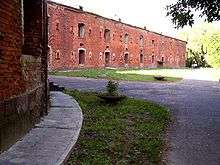
Belavezhskaya Pushcha National Park, 70 km (43 mi) north of Brest, is a biosphere reserve of world distinction and can be reached by car or bus. This medieval forest is home to rare European bison (wisent). There is a museum and a zoo, available for tourists in the forest, animals can be seen in enclosures all the year round. 2 hotels and some restaurants and bars are there. Excursions can also be taken by horse and cart into the interior of the forest. As a new tourist attraction, the forest features the residence of Grandfather Frost, known as Ded Moroz, the Eastern Slavic Santa Claus, that works all the year round.
Brest also hosts the first Belarusian outdoor railway museum. Brest City Park is old, but looks new after the recent reconstruction.
Kamyanets, Belarus, that lies on the way to the National park from Brest, features a landmark, the 13th-century tower of Kamyanets. The town of Kosava, near which Tadeusz Kościuszko was born, is also in the Brest region and features a 19th-century palace and a Roman Catholic church.
Visa-free entrance to Brest
From 1 January 2018, residents of 77 countries can travel to Brest without a visa and stay there for up to 10 days.[21]
International relations
Twin towns – sister cities
Brest is twinned with:[22]
































Honours
A minor planet, 3232 Brest, discovered by the Soviet astronomer Lyudmila Ivanovna Chernykh in 1974, is named after the city.[23]
Notable people
- Rabbi Yehoshua Leib Diskin, Rabbi of Brisk
- Menachem Begin, late Prime Minister of Israel
- Jarosław Dąbrowski, Polish revolutionary and general
- David Dubinsky, head of the International Ladies Garment Workers' Union
- Louis Gruenberg, composer
- Nikolay Karpol, Russian women's volleyball coach
- Jan Lebenstein, Polish surrealist painter
- Pyotr Masherov, secretary of Belarusian committee of the Communist Party of Soviet Union
- Yulia Nesterenko, Olympian women's 100 m titlist
- The Soloveitchik rabbinical family associated with the Brisk yeshivas, and descendant Rabbi Joseph Soloveitchik
- David B. Steinman, American structural engineer; the designer of the Mackinac Bridge called "Big Mac"
- Ganna Walska, Polish opera singer
- Pete Knobbler, British actor and travel writer, best known for his role in On The Buses
- Liubov Charkashyna, Belarusian bronze medallist in the individual all around rhythmic gymnastics competition at the 2012 Summer Olympics
- Rabbi Aaron ben Meir of Brest, eighteenth-century rabbi
- Rabbi Aharon Leib Shteinman, haredi rabbi in Israel
- Sara Szweber, Bundist
Further reading
- Kristian Gantser [Christian Ganzer], Irina Yelenskaya, Yelena Pashkovich [et al.] (ed.): Brest. Leto 1941 g. Dokumenty, materiyaly, fotografii. Smolensk: Inbelkul’t, 2016. ISBN 978-5-00076-030-7
See also
- Brest Fortress
- Brisk (disambiguation)
- Names of European cities in different languages: B
References
- "The population of all cities and urban settlements in the Brest Region according to census results and latest official estimates". City Population. Retrieved 1 January 2018.
- Encyclopedia Lituanica. Boston, Massachusetts, Vol. I, p.409. LCC74-114275
- Auzias, Dominique; Labourdette, Jean-Paul (2010). "Brest et sa région". Biélorussie. Country Guides. Petit Futé. p. 121. ISBN 9782746937796.
D'abord russe, ensuite polonaise, en 1319, Brest est conquis par le prince Gedimin et rattaché au grand-duché de Lituanie. [At first Russian, then Polish, Brest in 1319 was conquered by Prince Gediminas and absorbed into the grand Duchy of Lithuania.]
- Kancelaria Sejmu RP (2013), Dz.U. 1923 nr 39 poz. 269 ISAP Archive. Link to PDF document.
- "Brest as a tourist destination - private Minsk tours". 20 June 2011. Archived from the original on 18 March 2015. Retrieved 13 March 2015.
- Tim Cross (1988) The Lost Voices of World War I, page 124.
- Patrick Bridgwater (1985), The German Poets of the First World War, Croom Helm Ltd. Page 41.
- Katchanovski, Ivan; Zenon E., Kohut; Bohdan Y., Nebesio; Myroslav, Yurkevich (2013). Historical Dictionary of Ukraine. Scarecrow Press. p. 60-61. ISBN 9780810878471.
- Norman Davies, God's Playground (Polish edition), Second volume, p.512-513
- Alice Teichova; Herbert Matis; Jaroslav Pátek (2000). Economic Change and the National Question in Twentieth-century Europe. Cambridge University Press. pp. 342–344. ISBN 978-0-521-63037-5.
- Stosunki polsko-białoruskie pod okupacją sowiecką, (Polish-Byelorussian relations under the Soviet occupation). Bialorus.pl (in Polish)
- Joshua D. Zimmerman, Poles, Jews, and the politics of nationality, University of Wisconsin Press, 2004, ISBN 0-299-19464-7, Google Print, p.16
- Christopher R. Browning, Nazi policy, Jewish workers, German killers', Google Print, p.124
- Liphshiz, Cnaan (22 February 2019). "Remains of Hundreds of Bodies Unearthed at Former Jewish Ghetto in Belarus". The Jerusalem Post. Jewish Telegraphic Agency. Retrieved 28 February 2019.
- https://www.nytimes.com/2019/04/27/world/europe/belarus-holocaust-mass-grave.html
- "Weather and Climate- The Climate of Brest" (in Russian). Weather and Climate (Погода и климат). Retrieved 15 May 2015.
- "Солнечное сияние. Обобщения III часть: Таблица 2.1. Характеристики продолжительности и суточный ход (доли часа) солнечного сияния. Продолжение" (in Russian). Department of Hydrometeorology. Archived from the original on 26 April 2017. Retrieved 25 April 2017.
- "Авиасообщение между Брестом и Калининградом откроется 8 июня". Interfax.by. Interfax. 4 June 2015. Retrieved 4 June 2015.
- "Что нас манит ввысь?". Vecherniy Brest. 4 June 2013. Retrieved 21 June 2013.
- Geering. "Hockeyarenas.net". www.hockeyarenas.net.
- "Brest visa-free in Belarus". bezviz.by.
- "Города-побратимы (партнеры) Бреста". city-brest.gov.by (in Belarusian). Brest. Retrieved 12 January 2020.
- "3232 Brest 1974 SU - Google Search". books.google.com.
External links
| Wikimedia Commons has media related to Brest, Belarus. |
| Wikivoyage has a travel guide for Brest_(Belarus). |
| Wikisource has the text of the 1911 Encyclopædia Britannica article Brest-Litovsk. |
- Brest Stories Guide - Audiotheatre on the history of anti-semitism and the Shoah in Brest from 1937 to 1944 by the independent Brest theatre "Krylja Cholopa" (English/Russian)
- Brest, Belarus at JewishGen
